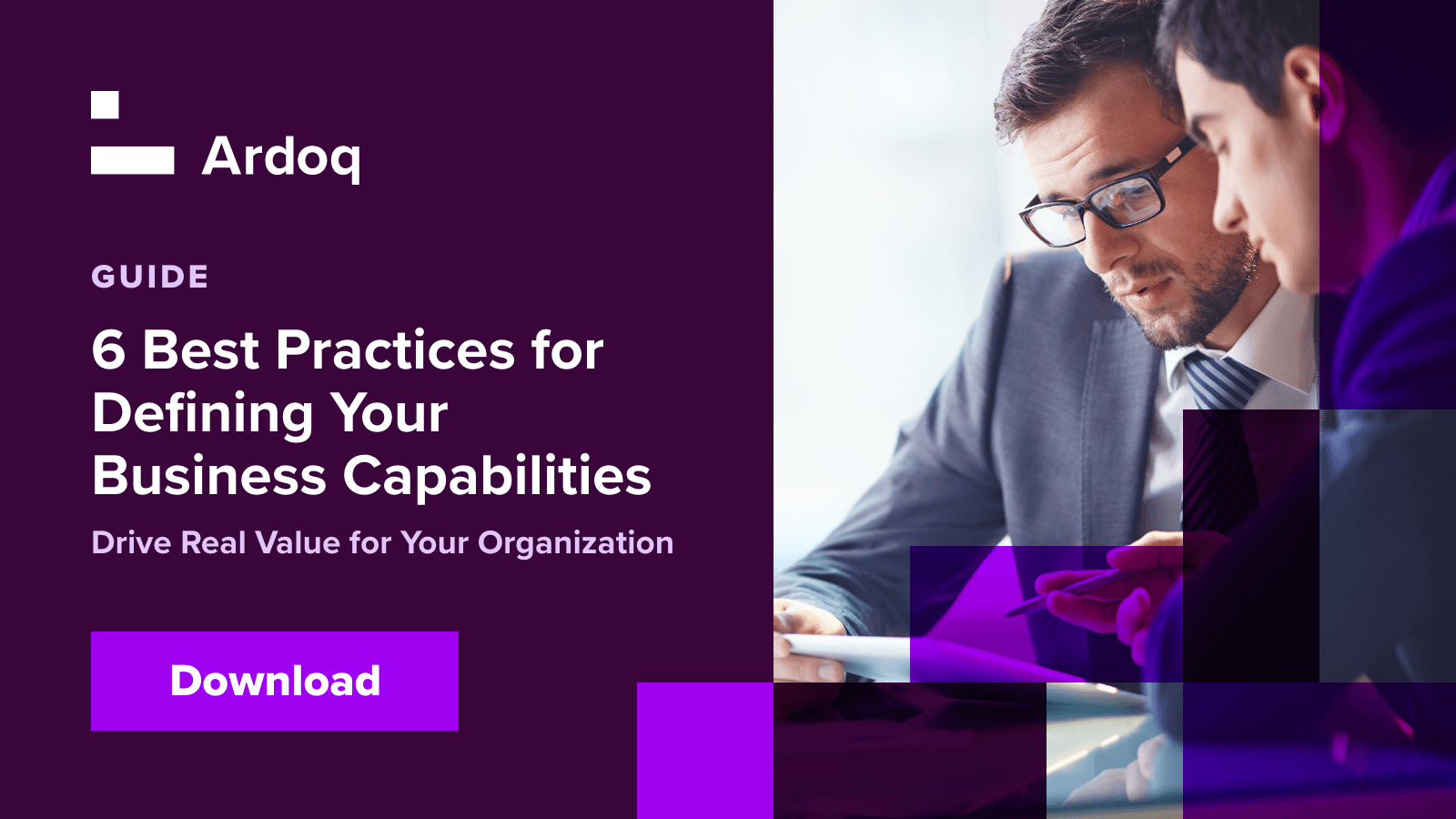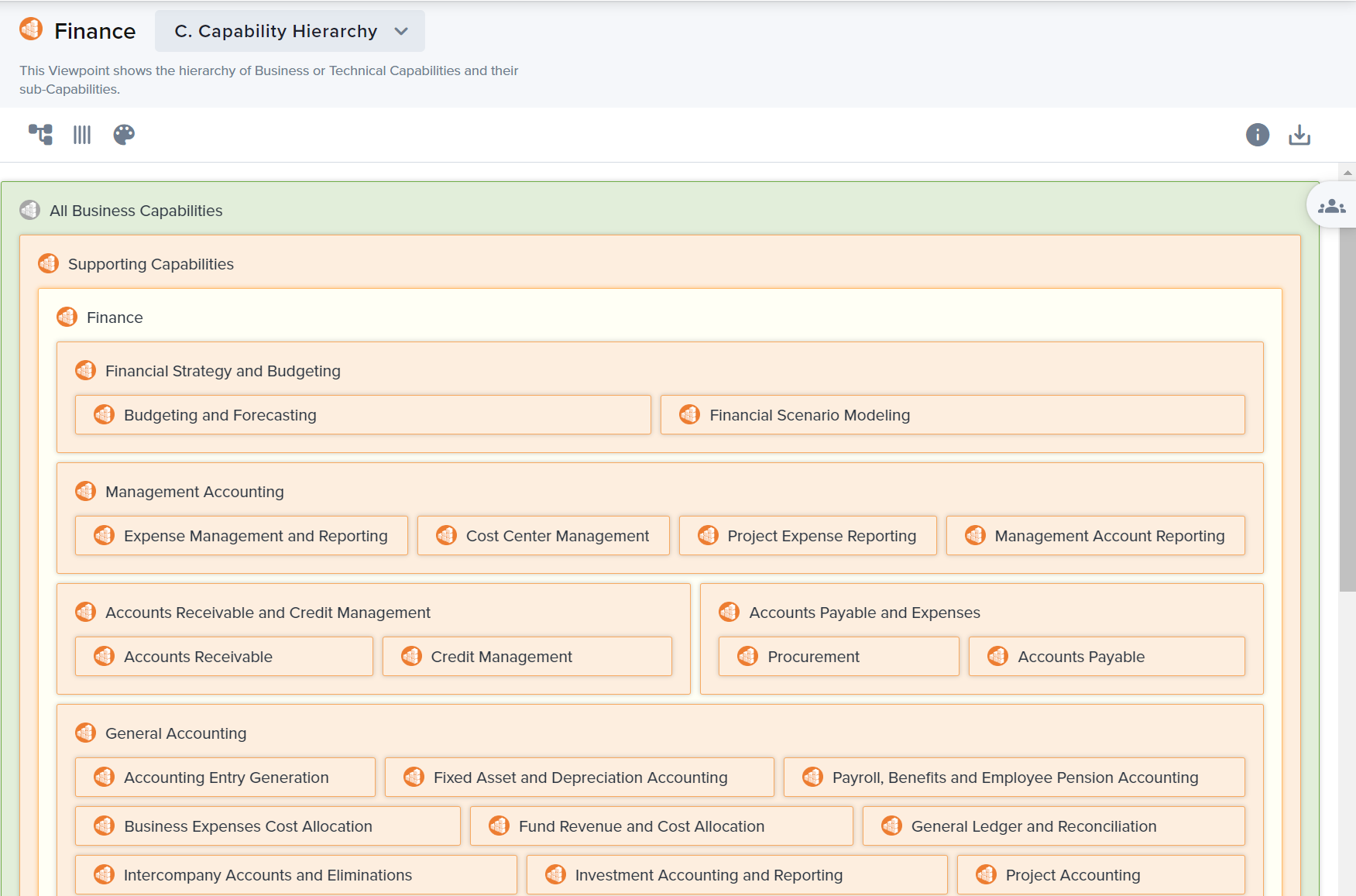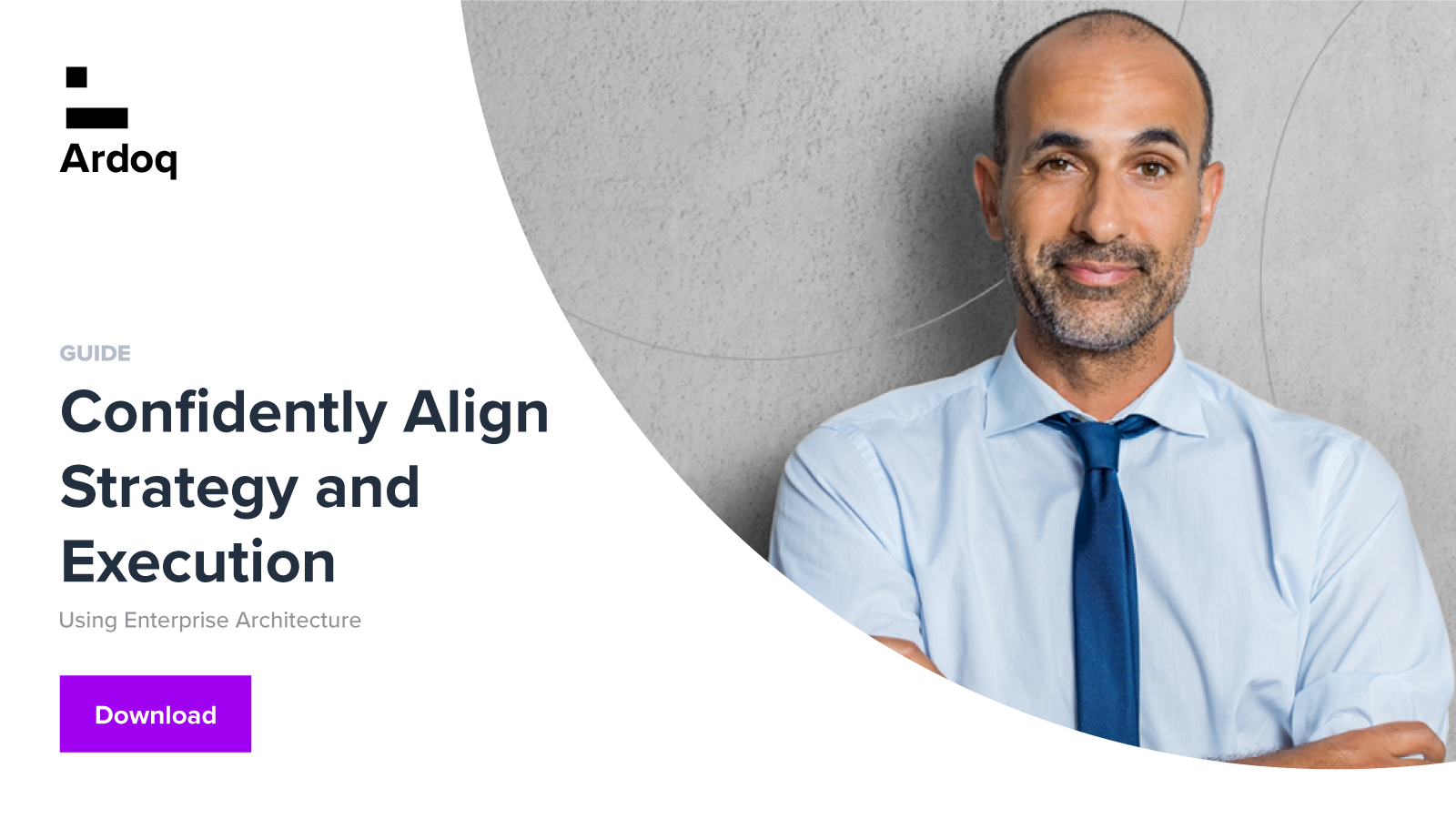Every business has a strategic set of goals to achieve success. To meet these objectives, every part of an organization must be aligned and work collaboratively. Unfortunately, though, this is where issues often arise. By not understanding their limitations and interdependencies, businesses run into roadblocks. This is where a business capability model is essential.
The better an organization understands its capabilities, the better it can work to maximize them and proactively address the ones that are most critical to its success.
But what exactly is a business capability model? More importantly, how can it help organizations be more successful and effective? This article will address each of these areas and more.
Jump to:
-
Business Capability Modeling Best Practices: Do’s and Dont’s
-
Business Capability Modeling Tools: Leverage the Power of People
-
How Ardoq Helps You Make the Most of Your Business Capability Model
What Is a Business Capability Model?
Business capability modeling (BCM) is a method for illustrating an organization's core business framework regardless of its structure, processes, personnel, or technology. As a platform for Enterprise Architects, business capability models can facilitate strategic discussions on investment or divestment opportunities. These capability models help companies understand and evaluate themselves.
Linking this information to strategic goals allows organizations to identify what kind of groundwork needs to be done to ensure a successful outcome in various organizational change projects. This ranges from procurement of a new system to department restructuring after acquiring or merging with another company.
4 Benefits of a Business Capability Model
Defining a business capability model can be a great starting point for businesses to get a common framework for analyzing performance across the business and IT.
Business capability modeling can quickly bring the following benefits:
-
An achievable, understandable asset that can be utilized across the entire business.
-
A bridge that connects strategy and IT architecture, becoming an intuitive common language for both.
-
Data-driven insights into many different areas across the organization.
-
A means of evaluating the business, such as measuring the success of change projects or analyzing performance.
Read our 6 Best Practices for Defining Your Business Capabilities for a quick, expert-guided approach to modeling business capabilities. 
Business Capability Modeling Is an On-Going Process
A common pitfall with business capability modeling is teams getting stuck arguing over the nuance of capability. Another pitfall is getting too involved in developing a complete model. The beauty of a business capability model is that it does not need to be fully defined or complete to start adding value.
A good reference model and the motivation for progress mean that capabilities can provide a quick win from the get-go for building an understandable vocabulary of what an organization does.
It is still important for architecture or digital change project teams to begin the process with some foundational discussions over what is valued as core to the business and how the business differentiates itself from competitors. Putting these things “down on paper” helps make the unspoken parts of the process clearer and more actionable, improving alignment across the enterprise.
A Business Capability Model Bridges Strategy With IT
Bringing the strategy out of the boardroom and connecting it to the business’ architecture is no easy feat. Too often, this is left to the Enterprise Architects or change-makers mediating between the business and IT, leading to solutions sometimes being lost in translation.
Business capability models address this communication issue by becoming the common language between business and IT, building alignment across the organization. This improves the translation and operationalization of strategy, a critical factor in successfully achieving enterprise-wide goals.
By drilling up to the capabilities different domain experts support, models help the team see how they are or should be positioned to deliver on a given strategy.
Below is an example of a business capability model in the Ardoq platform, illustrating how the overarching Finance capability can be broken down into sub-capabilities.
 Example: A Hierarchical Business Capability Model
Example: A Hierarchical Business Capability Model
How to Create a Business Capability Model In 4 Key Steps
We’ve explored the many benefits of the business capability model. Now, let’s look at how to create one. We’ve broken the process down into four vital steps.
Step 1: Assess Your Business Needs
The purpose of the business capability model is to help organizations align their operational functions with strategic objectives effectively. The first step, therefore, should be to carry out a thorough assessment of the needs of the business
Activities involved with this stage might include:
-
Collaborating with stakeholders across various organizational levels and departments to capture diverse perspectives. This holistic approach guarantees that the model mirrors the needs and visions of the entire organization rather than just a portion.
-
Analyzing external market trends, competitor actions, and industry benchmarks comprehensively. This external examination enables the organization to spot opportunities for differentiation and areas of potential risk.
-
Assessing current performance metrics and operational data meticulously to gauge the organization's strengths and weaknesses. This internal review helps identify areas where capabilities require development or enhancement.
-
Integrating Information Technology (IT) strategy from the outset. In today's digital era, IT is pivotal in enabling business capabilities. Early IT involvement ensures alignment of technology strategies with business objectives, facilitating smooth integration and support.
Step 2: Identify Needed Capabilities
Once a thorough assessment of the business's strategic requirements is established, the next phase involves pinpointing the capabilities necessary for attaining these goals. This procedure consists of:
-
Ranking capabilities according to their role in realizing strategic objectives and influencing the organization's competitive edge. This ranking process makes it easier to focus efforts and resources on areas likely to yield the greatest advantage.
-
Crafting a systematic hierarchy of capabilities, organizing them into different tiers based on their strategic significance and operational reach. This structured framework enhances comprehension of interconnections among capabilities and guarantees a holistic approach to capability enhancement.
Step 3: Identify Your Current Capabilities
Having gained a comprehensive understanding of the required capabilities, the organization must now evaluate its current capabilities to pinpoint gaps and areas for enhancement:
-
Undertaking a thorough gap analysis to compare existing capabilities with identified requirements. This analysis illuminates the organization's current deficiencies and highlights where investments in capability development are necessary.
-
Assessing the maturity levels of current capabilities, considering factors like effectiveness, efficiency, and integration with other capabilities, aids in identifying areas where existing capabilities can be refined or require substantial transformation.
Step 4: Link Capabilities With Applications
The last stage involves establishing explicit connections between the identified capabilities and the applications, processes, and technologies that underpin them:
-
Connecting each capability with precise supporting technologies and applications, along with the processes that facilitate them. This provides insight into what those capabilities rely on to be fulfilled and operationalized.
-
Recognizing opportunities for optimization and integration across processes and technologies. By seeking methods to streamline and augment support for essential capabilities, the organization can enhance efficiency and effectiveness.

Business Capability Modeling Best Practices: Do’s and Dont’s
There are plenty of pitfalls that can trip up even the most knowledgeable EA teams when building a business capability model. With that in mind, here are some things to remember for successful and effective business capability modeling.
Do’s
-
Think about the present and the future: Capabilities should encompass not only what the business is doing now but also what it will do in the future.
-
Involve teams in capability modeling: If teams are properly engaged, the model is more likely to resonate with them. Tapping cross-functional expertise and insight is important in having a capability model that accurately reflects the reality of the enterprise.
-
Be as granular as possible in descriptions to ensure clarity: Listing general capabilities isn’t enough, they must be accompanied by explanations of what each capability is for context.
-
When beginning with an Enterprise Architecture framework, remember to focus on modeling what is most important and relevant to the enterprise’s key challenges or objectives rather than adhering strictly to the framework.
Don’ts
-
Go too deep: Don’t overcomplicate the hierarchy of the capabilities and sub-capabilities. Model as much as is necessary for useful insight into the business.
-
Let capabilities overlap: Different capabilities may handle overlapping information or data, but the core functionality should be distinct.
-
Think of your model as a static deliverable: Businesses change and evolve continuously, so the business capability model should be a living artifact that evolves with it as needed.
These guiding principles will help, but if you want to get a head start on the modeling process, Ardoq also comes with out-of-the-box industry-specific reference models. These models are great accelerators for a BCM initiative and can be readily adapted to the nuances of any organization. Data can be easily imported via Ardoq’s wide selection of APIs and integrations.
What’s Next After Creating a Business Capability Model?
After following our business capability modeling best practices, look back to key business drivers and assess where the model would be best expanded. If managing IT spending is a critical priority, Application Portfolio Management and Application Rationalization are logical next steps.
If an organization has just undergone a merger and acquisition and needs an improved structure, adding people, departments, or business units to the model will aid this process.
Organizations can align strategy with the project portfolio using our approach to Strategic Planning and Execution, connecting the business strategy to how it impacts the architecture.

Building on a Business Capability Model
Business capability management can be the evaluation point of how well the business is currently doing in a given area. By connecting the capability model to other parts of the technological infrastructure, more insight can be unlocked for the organization.
By adding the technology or applications that realize capabilities, a business can identify:
- Cost savings through redundant or duplicate systems
- Risks where it is dependent on underperforming tech
- Opportunities where the right investment can increase the enterprise’s ability to differentiate in the market
An organization’s people can be an interesting way to evaluate a business when connecting them to capabilities. People can provide insights into expert networks, bottlenecks, or single points of failure. Including them in the business architecture can also be useful in many other ways.
Including people in an application portfolio management initiative, for example, can provide insights into responsibility and expert networks. It can also set the foundation for a far more data-driven approach to collaboration. By connecting capabilities to people, a business can identify:
-
Domain expert networks critical to business
-
Insights into responsibility
-
Areas of risk and opportunity (e.g., if some core differentiating capabilities are dependent on contractors or consultants)
Building out your business capability model in nearly any direction will provide additional value and actionable insights into how a business model is being implemented.

Example: How Business Capability Models can be connected to people, application portfolios, and departments
Business Capability Modeling Tools: Leverage the Power of People
It’s valuable and important for people to be included in an Enterprise Architecture effort, yet many business capability modeling tools are not equipped to include them. Ardoq places specific importance on ensuring that the tooling is people-focused by:
Including People-in-the-Graph
Having people in a graph-based, data-driven tool like Ardoq provides additional value to EA models. Ardoq is more than just an EA tool as it lends additional insight, such as who the domain experts are in an organization, who is responsible for a given application or system, and identifying areas of potential risk or opportunity.
Engaging People With Relevant Information at the Right Time
Mapping people into the graph means that Ardoq can identify the right people to notify for a given issue. This could be a crisis like a server outage or a technical error stopping a critical service. Having people included in the model means that it’s quick and easy to notify the correct individuals to mitigate and resolve issues. It is also possible to integrate this functionality with Slack or Gmail so that individuals can receive notifications on a platform they prefer.
One customer used Ardoq to inform external hosting providers of exactly what their servers and applications were supporting, giving them better insight into the business impact of what they were responsible for. This improved their vendor relationship and reduced the number of avoidable outages like scheduled maintenance unintentionally impacting key banking services.
Keeping People Accountable To Drive Quality
It has long been a challenge to keep people engaged to ensure the documentation is kept updated. While integrations help reduce this workload, it has also been found that including ownership and visibility across domains motivates people to maintain their information. These factors help to create a new level of awareness of how people depend on each other. Understanding that others depend on you to maintain documentation encourages a culture of ownership and quality in documentation.
Share Business Capability Models, Early and Often
Remember that building the business capability model is just the beginning. To uncover real value from it, it should be shared with peers, stakeholders, and managers. Only then does this visualization of the business and what it can do enable more meaningful discussions that drive better decisions.
Ardoq’s Presentations and Surveys allow organizations to begin sharing capability models, even as they are being developed, in a context that suits the recipient best. It is highly recommended to embed this model in the organizational intranet, Sharepoint, or Confluence pages, to bring awareness and transparency to the work being done. Exposing the model to more people in the company also means more opportunities for data collection or correction.
Surveys are an effective way to encourage users to contribute data without needing to understanding the core Ardoq platform. They are quick and easy to use, ideal for gathering data from teams outside the architecture or IT function.
Broadcasts are another function that aids engagement and improves communication. They allow Ardoq administrators to send the right messages to the right people at the right time. Using Broadcasts to send out surveys is a fast and efficient way to collect and validate data and keep it up to date.
How Ardoq Helps You Make the Most of Your Business Capability Model
An understanding of a business's capabilities is essential for achieving long-term success. A business capability model is a crucial way to improve alignment between IT and business operations.
At the heart of the modeling exercise should be the business needs and goals. Understanding how people, processes, and technologies drive these forward is critical. Data alone isn’t enough, it needs to be presented in a way that can provide actionable insights to various stakeholders
With Ardoq’s data-driven platform, you can move beyond static capability maps to easily assess maturity and impact. Our out-of-the-box solution for BCM can help kickstart your modeling initiative, equipping you with automatically generated data-driven visualizations and dashboards.
To experience the power, speed, and flexibility of the cloud-native Ardoq platform firsthand, contact us and request a demo today. 
- Blog Posts 9 Business Capability Examples For Improved Organizational Transparency Business Capabilities vs. Technical Capabilities
- PDF Guides 6 Best Practices for Defining Your Business Capabilities Navigating Turbulent Times With Digital Business Optimization
- Best Practice Guides Business Capability Modeling Business Capability Realization
 Ian Stendera
Ian is Ardoq's VP of Product. A multi-talent, he’s worked at Ardoq since 2014 and has built several teams across the company.
Ian Stendera
Ian is Ardoq's VP of Product. A multi-talent, he’s worked at Ardoq since 2014 and has built several teams across the company.

/Logos/Ardoq/RGB_Ardoq_Logo_Stacked_White_Monochrome%201.png?width=80&height=77&name=RGB_Ardoq_Logo_Stacked_White_Monochrome%201.png)

